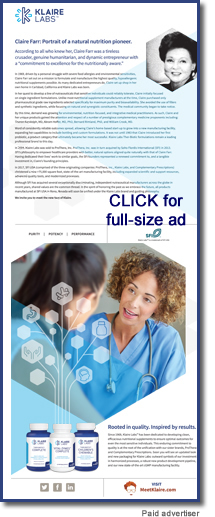|
Page 1, 2
Tiny organelles known as mitochondria are the body's equivalent of the batteries that power electrical devices. In other words, they are responsible for charging cells through the production of adenosine triphosphate (ATP), the energy molecule produced via the mitochondria's electron transport chain. Any factor that impairs mitochondrial function and disrupts the production of ATP can lead to fatigue, pain and inflammation as well as a significant number of diseases. For example, aging,1-4 chronic stress,5,6 certain pharmaceutical drugs,7 ingesting high-fructose corn syrup,8 environmental toxins such as heavy metals9 and air pollution,10 even the herbicides sprayed on food11,12 have all been found to impair mitochondrial function. In fact, in today's world, the mitochondria have a lot going against them.
The antioxidant coenzyme Q10 (CoQ10) is well known for its role in mitochondrial function. The overproduction of reactive oxygen species (ROS) by mitochondria is responsible for mitochondrial impairment and plays a major role in many diseases. Mitochondrial damage can be mitigated by improving mitochondrial antioxidant capacity through supplementing with ROS scavenger CoQ10, as it plays a critical role in the energy-producing electron transport chain. Known for its mitochondrial-enhancing properties, CoQ10 has been shown to lower mortality and increase exercise capacity in heart failure patients,13 diminish the frequency, duration, and severity of migraines,14 reduce wrinkles and improve smoothness of skin,15 and improve endothelial function and muscle recovery after strenuous exercise.16 CoQ10 is designed to sit in the inner mitochondrial membrane and does not cross cellular or mitochondrial membranes easily. For that reason, mitochondria manufacture CoQ10 inside the inner membrane and this is why the effectiveness of exogenous CoQ10 is significantly limited by its inability to reach the mitochondria.
In this article, we will discuss the role of CoQ10 in supporting mitochondrial function in various diseases with a special emphasis on a new mitochondria-targeted form of CoQ10 known as MitoQ (mitoquinol). Drs. Meletis and Bennett use this form of CoQ10 in their clinical practices, with much success.
 Townsend Letter provides a platform for those examining and reporting on functional and integrative medicine. Please support these independent voices. Townsend Letter provides a platform for those examining and reporting on functional and integrative medicine. Please support these independent voices. |
Enhancing the Bioavailability of CoQ10
Because of its lipophilic properties, large molecular weight, and differences in its gastrointestinal permeability, CoQ10 has low oral bioavailability and only a small amount of oral CoQ10 finds its way to the circulatory system.17 Intracellular delivery is also a challenge and only a small percentage of the absorbed CoQ10 is available to the mitochondria.17 An analysis of several studies indicates that high doses of CoQ10 supplementation for a prolonged period of time are needed to elevate CoQ10 tissue levels.18 Additionally, the increase of CoQ10 that occurs after supplementation varies in different tissues.18
 Many methods have been investigated to optimize CoQ10's ability to enter tissues and mitochondria including reducing particle size, creating emulsification and phospholipid delivery systems, with limited success.17 MitoQ researchers finally achieved success in enhancing the delivery of CoQ10 into the mitochondria when they attached the ubiquinol form of CoQ10 to the lipophilic triphenylphosphonium cation, which allowed CoQ10 to enter into the mitochondria driven by the large mitochondrial membrane potential.19 Many methods have been investigated to optimize CoQ10's ability to enter tissues and mitochondria including reducing particle size, creating emulsification and phospholipid delivery systems, with limited success.17 MitoQ researchers finally achieved success in enhancing the delivery of CoQ10 into the mitochondria when they attached the ubiquinol form of CoQ10 to the lipophilic triphenylphosphonium cation, which allowed CoQ10 to enter into the mitochondria driven by the large mitochondrial membrane potential.19
This combination of ubiquinol and the triphenylphosphonium cation, known as mitoquinol, or MitoQ for short, is positively charged. Through an electrical gradient, MitoQ is attracted to the negatively charged interior of the cell, passing through the cell's plasma membrane and ultimately penetrating the mitochondria's double membrane. Lipophilic cations like triphenylphosphonium are easily able to penetrate lipid bilayers because they possess a charge that is distributed over a large surface region and the potential gradient allows them to accumulate in the mitochondrial matrix.20,21
MitoQ is transported rapidly into isolated mitochondria. Inside the mitochondria virtually all of the acquired MitoQ is adsorbed to the matrix surface of the inner membrane.22 This ability of MitoQ to enter the inner membrane of the mitochondria substantially improves CoQ10's antioxidant capacity.22 MitoQ accumulates inside the mitochondria at concentrations up to a thousandfold greater than outside the cell.23 MitoQ is especially effective at delivering CoQ10 into tissues with high-energy needs where greater numbers of mitochondria are concentrated including neurons, cardiac muscle, and the liver and kidneys.22,23
Unlike many other forms of CoQ10, MitoQ is water soluble and demonstrates optimal oral bioavailability. Peak plasma levels are achieved in less than an hour.24 MitoQ is able to quickly penetrate all biological membranes, including the blood-brain barrier.25
The effects of MitoQ are probably attributed to accumulation of the ubiquinol form of CoQ10.26 After the ubiquinol form of MitoQ quenches a free radical, it is oxidized to ubiquinone. Soon after, Complex II recycles the ubiquinone back to ubiquinol, which is a more powerful antioxidant.26 Ubiquinol is highly effective at suppressing lipid peroxidation in phospholipid bilayers.27 Due to its recycling back to ubiquinol, MitoQ is especially effective against lipid peroxidation but can also reduce peroxynitrite and superoxide radicals.26
Potential Applications for Mitochondria-Targeted CoQ10
MitoQ has been extensively evaluated in preclinical studies and several human trials were conducted, with more on the way. The following is a brief review of the evidence for MitoQ's effectiveness.
Liver Health
Hepatocytes (liver cells) have a high concentration of mitochondria and therefore benefit from antioxidant protection. One of the first clinical trials to be conducted on MitoQ investigated its effects in patients with the hepatitis C virus (HCV).28 Increased oxidative stress and the ensuing mitochondrial damage are mechanisms responsible for the liver injury that occurs in chronic HCV infection. Inhibiting mitochondrial oxidative damage may therefore be beneficial. Consequently, researchers conducted a phase II study to determine the effect of MitoQ on serum aminotransferases and HCV RNA levels in patients with HCV. The study authors randomized 30 HCV patients who either did not respond to standard therapy or were unsuitable for standard-of-care to receive MitoQ (40 mg or 80 mg) or placebo once daily for 28 days. Patients receiving either dose of MitoQ experienced pronounced declines in absolute and percentage changes in serum alanine transaminase (ALT) from baseline to treatment day 28. ALT is a significant indicator of liver damage and inflammation. MitoQ did not affect HCV load.
MitoQ has also been studied for its supportive role in cirrhosis. In this disease, activated hepatic stellate cells (HSC) are involved in increasing intrahepatic vascular resistance and the development of portal hypertension.29 Cirrhosis is also associated with elevated reactive oxygen species in the liver, which may explain why antioxidants lower portal pressure.29 Because much of this increased ROS production originates in the mitochondria, researchers tested MitoQ on HSC from human livers, as well as on liver cells from control and cirrhotic rats.29 The researchers also conducted an in vivo experiment in rats in which the effects of 5 mg/kg/day of MitoQ for two weeks on oxidative stress, systemic and hepatic hemodynamics, liver fibrosis, HSC phenotype, and liver inflammation was compared to a control compound.29 MitoQ inhibited the activity of human and rat HSC. Furthermore, in the rat model, MitoQ reduced hepatic oxidative stress, improved the HSC phenotype, decreased intrahepatic vascular resistance, and suppressed liver fibrosis. These effects were accompanied by a pronounced decline in portal pressure without changes in arterial pressure.
Fibromyalgia and Chronic Fatigue Syndrome
Fibromyalgia is a disorder characterized by widespread pain and tenderness along with other symptoms including fatigue, cognitive problems, and poor sleep. Approximately 2% to 8% of the population suffers from fibromyalgia.30 Myalgic encephalomyelitis (ME) and chronic fatigue syndrome (CFS) are similar disorders to fibromyalgia and are characterized by malaise after exertion and unexplained, chronic fatigue. Scientists investigated the effects of MitoQ on 100 patients with fibromyalgia, CFS, or ME.31 The fibromyalgia patients taking MitoQ experienced significant declines in pain scores (up to 33%) while no change was observed in the placebo group. Furthermore, patients given MitoQ experienced a 13% increase in working memory. CFS/ME patients given MitoQ did not experience notable effects in a double blind trial, but significant improvements in pain, energy, sleep quality, and mental clarity were observed in a separate open-label arm of the experiment.31
Cognitive and Neurological Health
Alzheimer's disease is the most common neurodegenerative disease and an important cause of dementia among elderly individuals.25 Research indicates that mitochondrial impairment and oxidative stress are involved in Alzheimer's disease progression.25 Researchers studied whether MitoQ can suppress pathology similar to Alzheimer's in mouse cortical neurons in cell culture, and in a triple transgenic mouse model of Alzheimer's disease.25 In the cortical neurons, MitoQ diminished the neurotoxicity caused by amyloid beta (peptides that accumulate in Alzheimer's-affected brains), stopped the elevated production of reactive species, and decreased the loss of mitochondrial membrane potential. MitoQ given to mice for five months stopped the development of Alzheimer's-like pathologies such as cognitive decline, oxidative stress, Aβ accumulation, astrogliosis, synaptic loss, and caspase activation in the brain.
MitoQ also has been studied in Parkinson's disease, a chronic neurodegenerative disorder associated with neuronal mitochondrial dysfunction and low concentrations of the neurotransmitter dopamine. In mice, mesencephalic neuronal cells, and cultured dopaminergic cells exposed to toxins, MitoQ prevented neurotoxicity.32 In an in vitro model of Parkinson's disease, MitoQ inhibited mitochondrial fragmentation due to oxidative stress.33 A phase II, double-blind study of MitoQ versus a placebo in 128 Parkinson's patients did not demonstrate any effect of MitoQ on disease progression.34 This was likely due to the commencement of therapy when the neuronal injury was already too extensive to achieve any benefit from use of a neuroprotective agent. However, the study did demonstrate the excellent safety and tolerability of long-term use of MitoQ.
Maintaining Healthy Weight
Animal studies suggest MitoQ can protect against the effects of a high-fat diet. Mice prone to obesity that were given MitoQ in the drinking water and then fed a high-fat diet experienced a marked decline in total body mass and fat mass compared to mice fed a normal-fat diet.35 Mice given MitoQ and fed a high-fat diet also ate less food. Furthermore, MitoQ reduced fatty liver related oxidative damage.35
In another study by the same researchers, a dose of 500 μmol/L dose of MitoQ given to already obese mice caused the animals to drop too much weight and drink too little water so the researchers cut the dose in half.36 In this study, MitoQ had modest anti-obesity benefits. Primarily, MitoQ resulted in a robust decline in plasma leptin, an important marker of fat mass.
Page 1, 2
|
![]()
![]()
![]()
![]()






